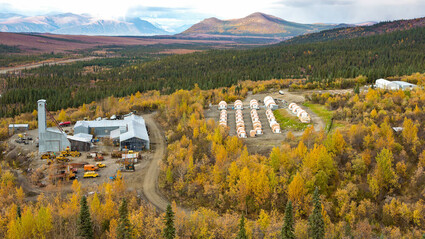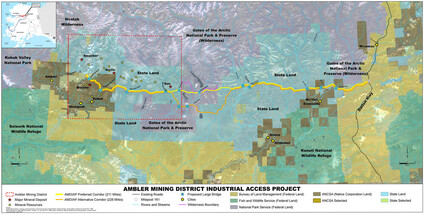Two Arctic boroughs support Ambler Road
North of 60 Mining News – April 14, 2023
Last updated 5/1/2023 at 9:42am

NANA Corp.
Bornite Camp sits atop a world-class copper-cobalt deposit at the western terminus of the proposed Ambler Road.
North Slope and Northwest Arctic boroughs ink joint resolution in favor of Ambler access.
The Northwest Arctic and North Slope boroughs have put their combined political weight behind an effort to push the U.S. Department of Interior to expediently reapprove a road to the copper- and zinc-rich Ambler Mining District in Northwest Alaska.
Located about 200 miles west of the Dalton Highway, a lone transportation artery that connects Alaska's North Slope with the rest of the state, the Ambler Mining District is rich in high-grade deposits of copper, zinc, and other metals critical to a world transitioning to clean energy.
A proposed industrial access road that runs 211 miles west from the Dalton Highway would provide an economical means of delivering mineral concentrates enriched with copper, zinc, silver, and cobalt to markets demanding reliable supplies of these energy transition metals.
In 2020, the U.S. Bureau of Land Management and National Park Service, both of which fall under the Interior Department, approved the federal authorizations needed to build this road formally known as the Ambler Access Project.
Roughly a year ago, however, BLM notified the Alaska Industrial Development and Export Authority, which would build the road and recoup expenses from tolls charged to mining companies, that it had suspended its Ambler Road authorizations for further review.
The federal land manager cited a lack of adequate consultation with Alaska tribes and evaluation of potential impacts the road might have on subsistence uses as reasons to remand the previously issued authorizations.
The Northwest Arctic and North Slope boroughs, which represent a combined 19 Alaska Native communities across 135,500 square miles of Alaska's northernmost reaches, contend that responsible development can go hand-in-hand with protection of subsistence culture and resources.
The joint resolution approved by both borough assemblies also underscores the importance of copper, zinc, cobalt, and other metals found in the Ambler District to manufacturing electric vehicles, renewable energy infrastructure, high-tech devices, and defense systems.
"Resource development, when carried out in a way that respects our subsistence lifestyle, culture, and the wellbeing of the land has the potential to create progressive economic and employment outcomes for the people of our communities," said Northwest Arctic Borough Mayor Dickie Moto.
Growing support
The joint resolution from these two northernmost Alaska boroughs adds to the growing number of Alaska Native organizations that support the Ambler Road development.
Earlier this year, the tribal councils of Allakaket and Huslia unanimously voted to withdraw from a lawsuit against the previous federal decision to issue permits for the industrial access road.
"Our council and community have considered both the concerns and potential benefits from the responsible development of our lands," Gordon Bergman, second chief of the Allakaket Village Council, said regarding the decision to withdraw from the lawsuit. "We believe it's important to recognize that we now walk in two worlds – continuing to respect and value our culture and subsistence lifestyles while also embracing the opportunity for economic growth and stability for our people through higher education and jobs."
And much like the boroughs to the north and northwest of their communities, these tribal councils are taking into consideration what development in the Ambler District means at the national level.
"The Ambler Access Project and the development of the Ambler Mining District has the potential to provide not only jobs, but also the critical minerals necessary for our national security," said Carl Burgett, chief of the Huslia tribal council. "We should not depend on foreign sources of these minerals when they can be developed more responsibly on our lands, to the benefit of our people and the entire nation."
Encouraging development
The growing support for the proposed road is welcome news for Ambler Metals, a 50-50 joint venture between Trilogy Metals Inc. and South32 Ltd. that has invested hundreds of millions of dollars advancing mining projects at the west end of the proposed Ambler Road.
"The joint resolution is a very encouraging development with two regions working together to explore the economic possibilities that responsible development of the Ambler Mining District could bring to the area," said Ambler Metals President and CEO Ramzi Fawaz.
A feasibility study updated earlier this year details plans for a mine at Arctic, the first mine Ambler Metals plans to develop in the district, that is expected to produce 1.93 billion pounds of copper, 2.24 billion lb of zinc, 334.8 million lb of lead, 423,000 ounces of gold, and 36 million oz of silver over an initial 13 years.
This operation is based on 46.7 million metric tons of probable reserves averaging 2.11% copper, 2.9% zinc, 0.56% lead, 0.42 grams per metric tons gold, and 31.8 g/t silver.

Alaska Industrial Development and Export Authority
The proposed 211-mile Ambler Road would provide access to Ambler Metals' Upper Kobuk Mineral Projects and other deposits in the Ambler Mining District of Northwest Alaska.
The company is also advancing plans to develop a mine at Bornite, a world-class copper-cobalt deposit that lies on Alaska Native lands owned by NANA Corp.
The wider Ambler District hosts dozens of other deposits and prospects that would provide economic benefits to northern Alaska communities, provide revenues to the state, and provide a domestic supply of minerals critical to the U.S. and its transition to clean energy and transportation.
"The mineral resources in the area, including copper, are of critical importance to the country," Alaska Congresswoman Mary Peltola penned in a previous letter of support for the Ambler Road. "The minerals are there; the state and private interests in exploring and developing those resources are in place; the support of Alaska Native corporation and tribes is strong. What is missing is access, which the project would provide."
BLM currently anticipates issuing a final record of decision on the revised Ambler Road permits by the end of 2023.


















Reader Comments(0)